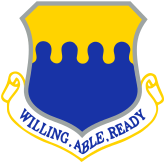
The 305th Air Mobility Wing is a United States Air Force strategic airlift and air refueling wing under the operational control of the Air Mobility Command. It generates, mobilizes and deploys C-17 Globemaster III and KC-10 Extender aircraft. The 305th AMW is a tenant unit at mostly the McGuire AFB component of Joint Base McGuire-Dix-Lakehurst in central New Jersey. It also controls one of the Air Force's busiest aerial ports, and the air operations at both McGuire Air Force Base and Naval Support Activity Lakehurst.

The 72nd Air Base Wing is a United States Air Force unit assigned to the Air Force Sustainment Center at Tinker Air Force Base, Oklahoma. It has been the host unit at Tinker since activating there on 1 October 1994.

The 19th Airlift Wing is a United States Air Force unit assigned to the Air Mobility Command's Eighteenth Air Force. It is stationed at Little Rock Air Force Base, Arkansas. The wing is also the host unit at Little Rock.
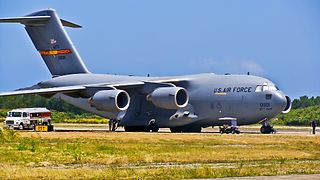
The 97th Air Mobility Wing is a United States Air Force (USAF) unit assigned to Nineteenth Air Force of Air Education and Training Command. It is stationed at Altus Air Force Base, Oklahoma. The wing is also the host unit at Altus. It plans and executes McDonnell Douglas C-17 Globemaster III, Boeing KC-46, and Boeing KC-135 Stratotanker pilot and aircrew training, providing formal school initial and advanced specialty training programs for up to 3,000 students annually. The training is done in a three-phase approach: Academic Phase, Simulator Phase, and Flying Phase.

The 92d Air Refueling Wing is a United States Air Force unit assigned to the Air Mobility Command Eighteenth Air Force. It is stationed at Fairchild Air Force Base, Washington. The wing is also the host unit at Fairchild. The wing carries out air refueling, passenger and cargo airlift, and aero-medical evacuation missions.

The 376th Air Expeditionary Wing is an inactive wing of the United States Air Force. It was last stationed at the Transit Center at Manas International Airport, Kyrgyz Republic, supporting U.S. and ISAF operations in Afghanistan.
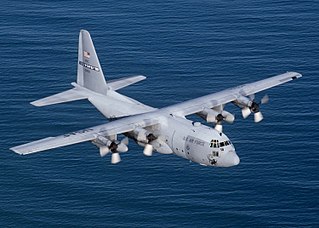
The 43rd Air Mobility Operations Group is an active duty air mobility unit at Pope Field, Fort Bragg, North Carolina and is part of the Air Mobility Command (AMC) under the USAF Expeditionary Center. The unit is composed of five squadrons, including one of the only two active Air Force aeromedical evacuation squadrons based in the United States. The group's primary mission focuses on providing enroute operations and enabling global response and airborne support for Fort Bragg's 82nd Airborne Division.

The 17th Training Wing is a United States Air Force unit assigned to the Air Education and Training Command Second Air Force. It is stationed at Goodfellow Air Force Base, Texas. The wing is also the host unit at Goodfellow. It was activated as a non-flying wing on 1 July 1993. Its mission is to train intelligence personnel in all the branches of the armed forces, as well as firefighters and a few other specialties. The wing trains Air Force enlisted intelligence, cryptology and linguist AFSCs 1N0, 1N1, 1N2, 1N3, 1N4, 1N5, 1A8, Air Force intelligence officer AFSC 14N, and military firefighters from all branches. Many corresponding Army, Navy, Space Force, and Marine Corps intelligence personnel are also trained at Goodfellow AFB, and assigned to the local units.

The United States Air Force's 6th Air Refueling Wing is the host wing for MacDill Air Force Base, Florida. It is part of Air Mobility Command's (AMC) Eighteenth Air Force. The wing's 6th Operations Group is a successor organization of the 3d Observation Group, one of the seven original combat air groups formed by the United States Army Air Service shortly after the end of World War I.

The 22d Air Refueling Wing is a United States Air Force unit assigned to the Air Mobility Command's Eighteenth Air Force. It is stationed at McConnell Air Force Base, Kansas and also functions as the host wing for McConnell.

The 384th Air Expeditionary Wing is an inactive unit of the United States Air Force. Its last assignment was with the United States Central Command Air Forces, being stationed at Shaikh Isa Air Base, Bahrain. It was inactivated in 2004. The wing's mission is largely undisclosed. However, it is known that one of its missions was aerial refueling of combat aircraft.
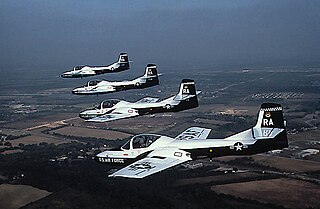
The 340th Flying Training Group is a reserve component of the United States Air Force. It is assigned to the Twenty-Second Air Force of Air Force Reserve Command, at Randolph Air Force Base, Joint Base San Antonio, Texas. The group is the headquarters for reserve flying training squadrons that are associate squadrons of Air Education and Training Command flying training squadrons.

The 465th Bombardment Wing is an inactive United States Air Force unit. It was last assigned to the 57th Air Division of Strategic Air Command at Robins Air Force Base, Georgia, where it was inactivated on 21 July 1968.
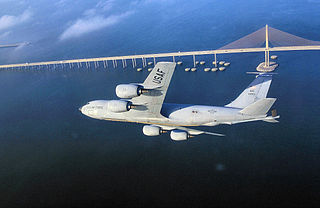
The 91st Air Refueling Squadron is part of the 6th Air Mobility Wing at MacDill Air Force Base, Florida. It operates the Boeing KC-135R Stratotanker aircraft conducting air refueling missions.

The 97th Air Refueling Squadron is an active unit of the United States Air Force, stationed at Fairchild Air Force Base, Washington. It was most recently activated on 1 October 2019 and assigned to the 92nd Operations Group, 92nd Air Refueling Wing.

The 65th Special Operations Squadron is an Air Force Special Operations Command unit which flies the General Atomics MQ-9 Reaper at Hurlburt Field, Florida. The squadron was first activated as the 65th Bombardment Squadron in January 1941, one of the original squadrons of the 43rd Bombardment Group. Following the attack on Pearl Harbor, the squadron participated in antisubmarine patrols until January 1942, when it moved to Australia and the Southwest Pacific Theater. It moved forward with US forces through New Guinea and the Philippines, moving to Ie Shima shortly before V-J Day for operations against Japan. It earned two Distinguished Unit Citations and a Philippine Presidential Unit Citation for combat operations. During this period, a crew from the 65th became the most decorated aircrew in United States history, when their B-17 fought off twenty Japanese fighters during a photo reconnaissance mission. The squadron was inactivated in the Philippines in April 1946.

The 97th Operations Group is a United States Air Force unit assigned to the 97th Air Mobility Wing of Air Education and Training Command. It is stationed at Altus Air Force Base, Oklahoma.

The 53rd Electronic Warfare Group was a component of the 53rd Wing of the Air Force Warfare Center, Air Combat Command, headquartered at Eglin Air Force Base, Florida.
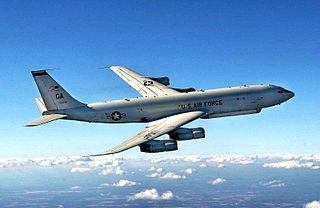
The 461st Air Control Wing is a joint Air Force/Army unit flying the E-8 J-STARS aircraft. The wing is assigned to Air Combat Command's Ninth Air Force, and is stationed at Robins Air Force Base, Georgia. It was activated on 1 October 2011.

